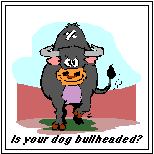

"My dog is so stubborn.
He just sits there and looks at me when I call
him."
"He won't go over the
jump. I can't believe how stubborn he is!"
These are just two examples of how stubborn dogs can be; I have heard
many similar comments in my years of dog showing and training. I know
I must have made the same statements about one of my first dogs.

Since then, luckily for my
dogs, I have learned a great deal about dog behavior. Although dogs
are not just tame wolves, many of their drives and behaviors stem
from this lupine heritage. In wolves behaviors had to enhance their
chances for survival in a world that was not very friendly. If a
behavior did not help a wolf find shelter, food, or water, the wolf
died or the behavior disappeared.
So, let's look at the behaviors
that we label as stubbornness. If a wolf were to act in a stubborn
manner, he might look at a rabbit and think, "I'm not going to move.
That rabbit had better come to me." The wolf is going to get very
hungry, very quickly. I doubt if this behavior would last for any
length of time. Any wolf behavior that didn't last long wasn't
inherited by modern dogs.
Could it be possible that what
we have been calling "stubborn" all these years could really be
something else entirely? Let's look at the two scenarios at the
beginning of the article, and see if there might not be some
explanation other than stubbornness for these behaviors.
Dog number one just looks at
his owner when he is being called. One explanation could be that the
dog does not understand the command "come". More likely, the dog has
learned that "come" sometimes means "When I get my hands on you, I'm
going to hit you" or "When I get you, whatever fun you are currently
having is over". Why would a dog choose to obey a command that is
painful of could end his fun? To end the "stubborn" behavior we need
to change what the word "come" means to the dog. Dogs that come
quickly have learned that "come" means "If I get over to the person
who is calling me, I may get a treat". Don't call your dog to you to
punish him. He will associate the punishment with coming to you.
Likewise, don't only use "come" at the end of a play session. Call
your dog in the middle of a game, give him a treat, and then keep
playing. Reward speed with extra good treats or lots of pats. For
more information on behavior and consequences check out my article on
consequences
and behavior.
 The second dog would not go over the jump. It could be because the
dog doesn't understand what she is being asked to do. More seriously,
the dog could be experiencing pain when she jumps. Dogs can't say,
"Ouch, that hurts." A stoic dog may not yelp. When starting to jump
your dog, warm him up, just as you would warm up before going
jogging.
The second dog would not go over the jump. It could be because the
dog doesn't understand what she is being asked to do. More seriously,
the dog could be experiencing pain when she jumps. Dogs can't say,
"Ouch, that hurts." A stoic dog may not yelp. When starting to jump
your dog, warm him up, just as you would warm up before going
jogging.
If your dog is usually a couch
potato, proceed slowly and build up to full height over a period of
time. Remember, young puppies are growing, and excessive stress on
their bones, muscles, tendons, and ligaments at a young age can
produce life-long injuries. And if you are not sure your dog is
physically capable of jumping the heights you are requiring, make an
appointment with your vet.
In conclusion, next time your
dog does something and you find yourself about to utter the S
word; stop and think. Could there be some other explanation that
makes more sense from your dog's point of view?
 This page was created by and
is copyrighted to Beth
MacLehose. If you notice
any graphics I have used that are yours and you would prefer I not
use them let me know and I will remove them. Also all pictures and
text is copyrighted to me or the cited author. Please email the
author for permission to use material you find here.
This page was created by and
is copyrighted to Beth
MacLehose. If you notice
any graphics I have used that are yours and you would prefer I not
use them let me know and I will remove them. Also all pictures and
text is copyrighted to me or the cited author. Please email the
author for permission to use material you find here.